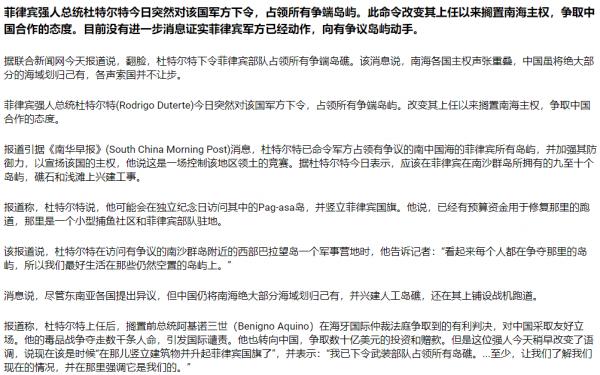| 羅援下令擊沉兩美航母狂妄美帝竟然還嘴?! |
| 送交者: Pascal 2019年12月20日01:29:58 於 [五 味 齋] 發送悄悄話 |
|
中美南海大決戰 民族英雄羅援將軍下傳軍令 先擊沉美軍兩艘航空母艦 擊斃他一萬美軍再說後話 兇惡反黨反華反人類美帝氣焰囂張 竟然指名道姓 狂妄還嘴?!
By David Axe January 10, 2019 A Chinese admiral and pundit told a trade-show audience that Beijing could resolve China's territorial disputes by sinking two U.S. Navy aircraft carriers and killing thousands of American sailors. Rear Adm. Lou Yuan's threat isn't an empty one. The Chinese military has deployed an array of weaponry that it acquired specifically to target American flattops. But a U.S. Navy test in 2005 proved that even if you hit them, carriers are really hard to sink. Lou made his provocative comment on Dec. 20, 2018 at the Military Industry List summit, according to media reports. “What the United States fears the most is taking casualties,” declared Lou, an anti-American author, social commentator and military theorist at the PLA Academy of Military Science. Sinking just one carrier could kill 5,000 Americans, Lou pointed out. Sink two, and you double the toll. "We’ll see how frightened America is" after losing 10,000 sailors, Lou crowed. Leaving aside the likelihood of a full-scale war breaking out between the world's two leading military powers and economies, sinking a carrier is easier said than done. History underscores the difficulty of the undertaking. In 1964 Viet Cong saboteurs managed to damage and briefly sink the former U.S. Navy escort carrier Card while the vessel, then operating as an aircraft ferry for U.S. Military Sealift Command, moored in Saigon. But the last time anyone permanently sank a U.S. Navy aircraft carrier in combat was during World War II. Twelve American carriers sank during the war, usually following intensive air attacks. The last to sink, USS Bismarck Sea, fell victim to Japanese kamikazes in February 1945. In subsequent decades, American flattops suffered serious accidents including collisions and fires, but none sank. It's very difficult to sink a buoyant, thousand-feet-long ship that's mostly made of steel. The U.S. Navy knows this from experience. In 2005, the Navy itself targeted the decommissioned carrier America in order to determine just how much punishment the vessel could withstand before slipping beneath the waves. "The ship was pummeled by explosions both above and below the waterline," The War Zone reporter Tyler Rogoway explained in 2018. "After nearly four weeks of these activities, the carrier was scuttled. On May 14, 2005, the vessel's stern disappeared below the waterline and the ship began its voyage to the seafloor." "America stood up to four weeks of abuse and only succumbed to the sea after demolition teams scuttled the ship on purpose once and for all, it's clear that America was built to sustain heavy damage in combat and still stay afloat." Consider also the carrier-shaped pontoon ship that Iran built as a scale target for a 2015 war game. While small and flimsy compared to a real flattop, the pontoon vessel itself endured an intensive assault. "Iran struck the faux carrier with a barrage of anti-ship missiles, then swarmed it with small boats and then landed commandos on it," Rogoway reported. Still, the fake flattop apparently remained afloat. To even try to sink an American flattop, you first must hit it. That's not easy, either. No carrier sails without an air wing with as many as 50 fighter aircraft plus several escorting destroyers, cruisers and submarines. A virtual wall of defensive weaponry surrounds the flattop out to a distance of several hundred miles. Still, China or another country could attempt to target the carriers with submarines, cruise missiles and ballistic rockets. "They will employ multiple systems in order to confuse and overwhelm U.S. defenses," naval historian Robert Farley wrote in 2017. "They will rely on the threat of attack to keep U.S. carrier battle groups as far as possible from the main theaters of operation." "But the observation that the enemy has a missile or torpedo that can kill a carrier only begins a conversation about carrier vulnerability," Farley continued. "Shooting anything at an aircraft carrier is a costly, difficult operation." The carrier's attackers could face withering counterfire from the vessel's defenders. "Beyond the monetary cost, launching an open attack against an American carrier strike group, with its own cruisers, destroyers and submarines, is almost certainly a suicide mission." And if the United States' reaction to the 9/11 terror attacks is any indication, Washington surely would deploy all its remaining military might, including its surviving eight or nine carriers, against country behind the sinking. "So there are two questions that remain for anyone who thinks they even have a shot at taking down one of these enormous steel behemoths," Farley explained. "Can you do it? And even if you can, is it worth it?" David Axe serves as the new Defense Editor of the National Interest. He is the author of the graphic novels War Fix, War Is Boring and Machete Squad. 谷歌同志一秒鐘完工譯文: 一位中國海軍上將和專家告訴貿易展的觀眾,北京可以通過擊沉兩艘美國海軍航空母艦並殺死數千名美國水手來解決中國的領土爭端。 陸圓上將的威脅並不是空洞的。中國軍方已部署了一系列武器,專門針對美國平頂而購置。 但是2005年美國海軍進行的一次測試證明,即使您將其擊中,航母也確實難以下沉。 據媒體報道,婁在2018年12月20日的軍事工業名單峰會上發表了挑釁性的評論。 解放軍軍事科學院反美作家,社會評論家和軍事理論家婁說:“美國最擔心的是人員傷亡。” 婁指出,沉沒一艘航母可以殺死5,000名美國人。下沉兩個,則通行費加倍。勞失去了10,000名水兵後,“我們將看到美國感到多麼恐懼”。 撇開世界上兩個主要軍事大國和經濟體之間爆發全面戰爭的可能性,沉沒航母說起來容易做起來難。歷史強調了這項工作的難度。 1964年,越共破壞分子設法損壞並短暫擊沉了前美國海軍護衛艦卡德,當時該船隨後作為停泊在西貢的美國軍事海上運輸司令部的飛機渡輪使用。 但是上一次有人在戰鬥中永久沉沒美國海軍航空母艦是在第二次世界大戰期間。十二架美國航母在戰爭期間沉沒,通常是在密集空襲之後。最後下沉的Bi斯麥號戰艦於1945年2月成為日本神風敢死隊的受害者。 在隨後的幾十年中,美國的平板電腦遭受了嚴重的事故,包括碰撞和火災,但沒有發生沉沒。沉沒一艘主要由鋼製成的浮力長達數千英尺的船是非常困難的。 美國海軍從經驗中知道這一點。在2005年,海軍本身以退役的美國母艦為目標,以確定在滑入海浪之前船隻可以承受的懲罰程度。 戰區記者泰勒·羅戈威(Tyler Rogoway)在2018年解釋說:“船在水線之上和之下都受到爆炸的襲擊。經過近四周的這些活動,航母被擊沉。2005年5月14日,船尾消失在下面。水線和輪船開始航行到海底。” “美國遭受了長達四個星期的虐待,直到拆除隊一勞永逸地將船拆毀後才屈服於大海,很顯然,美國的建立是為了在戰鬥中承受沉重的破壞,並仍在繼續航行。” 還要考慮伊朗建造的航母型浮橋船,這是2015年戰爭的規模目標。與真正的平頂船相比,儘管體積小而脆弱,但浮船本身卻遭受了強烈的攻擊。羅格韋說:“伊朗用一枚反艦導彈擊中了這艘人造航母,然後用小船將其擁擠,然後將突擊隊降落在其上。” 儘管如此,假冒的平板電腦顯然仍在漂浮。 甚至要沉沒美國平板電腦,您首先必須擊中它。這也不容易。如果沒有帶有多達50架戰鬥機以及幾輛護航驅逐艦,巡洋艦和潛艇的機翼,沒有航母就能航行。一面虛擬的防禦性武器牆將平板架包圍了數百英里。 儘管如此,中國或其他國家仍可以嘗試用潛艇,巡航導彈和彈道火箭瞄準航母。 海軍歷史學家羅伯特·法利(Robert Farley)在2017年寫道:“他們將採用多種系統來迷惑和壓倒美國的防禦。他們將依靠攻擊的威脅使美國航母戰鬥群儘可能遠離主要戰區。 ” “但是,觀察到敵人擁有可以殺死航母的導彈或魚雷,才開始談論航母的脆弱性,”法利繼續說道。 “在航空母艦上射擊任何東西都是昂貴,困難的操作。” 承運人的攻擊者可能會面對船舶防禦者的強大逆火。 “除了金錢成本之外,對擁有自己的巡洋艦,驅逐艦和潛艇的美國航母打擊組織發起公開攻擊幾乎肯定是一個自殺任務。” 而且,如果美國對9/11恐怖襲擊的反應有任何跡象,華盛頓肯定會部署所有剩餘的軍事力量,包括倖存的8或9艘航母,向沉沒背後的國家部署。 法利解釋說:“因此,對於那些認為自己甚至有能力擊落其中一個巨大的鋼鐵龐然大物的人來說,還有兩個問題。” “你能做到嗎?即使可以,這值得嗎?” 大衛·艾克斯(David Ax)擔任國家利益的新國防編輯。他是圖畫小說《戰爭修正》,《戰爭無聊》和《彎刀小隊》的作者。
Repeat:
****************************** “給錢給煩了嗎?” “不是給錢給煩了,而是聽話聽煩了。 錢我們不吝惜,要多少吧,一百萬,一千萬?” “甚至能給一萬萬。” “隨便吧。割半個俄國嗎,我們割。”
“ 看字看煩了嗎?” “ 不是看字看煩了,而是看圖看煩了!”
這哪裡是2019年12月16日鳩山由紀夫的容貌?
這是2019年12月15日星期日 人還在日本的 日本前首相鳩山由紀夫同志參加 第3回共和黨結黨準備會 長達2:48:05視頻截圖:
視頻鏈接: https://twitter.com/ding_gang/status/1207281271833006081 這是新聞聯播報道2019年12月16日巴基斯坦前總理 肖卡特·阿齊茲同志在北京與王主席(副)合影 面部特寫:
這是2019年12月16日完全同一天 阿齊茲同志 人正在瑞士日內瓦合影照 面部特寫:
這是新聞聯播報道2019年12月16日 楊潔篪同志面部特寫寫真:
這是2019年9月11日楊潔篪同志面部寫真:
請逐一點擊照片來源鏈接 驗明正身: 這是2019年11月1日楊潔篪同志面部寫真:
https://6do.news/article/1866905-61 這是2019年12月3日面部特寫寫真:
http://tv.cctv.com/2019/12/03/VIDEVCZcrOtDm8hd8mrHglit191203.shtml?spm=C52056131267.PMXrRQiRmhAk.0.0 這是2018年11月8日:
http://sputniknews.cn/politics/201811081026775341/ 始自 13:10 |
|
|
 | |||
|
 |
| 實用資訊 | |
|
|
| 一周點擊熱帖 | 更多>> |
| 一周回復熱帖 |
| 歷史上的今天:回復熱帖 |
| 2018: | 看看這篇文章吧,寫得太準確了。 | |
| 2018: | 川普終於把大好的美國經濟搞砸了 | |
| 2017: | 稅改通過了!! | |
| 2017: | 對於東亞國來講,鼓吹抗日的人就是賣國 | |
| 2016: | 總統與國家利益衝突--即將到來的憲法危 | |
| 2016: | 國內的霧霾的確很嚴重。 | |
| 2015: | 阿巫在嗎? | |
| 2015: | 溪谷閒人:故宮故事.北京旅遊必讀2 | |
| 2014: | 種族歧視的實質是什麼? | |
| 2014: | 我秀一下我的鍛煉成果,不過還是要加油 | |





















































































